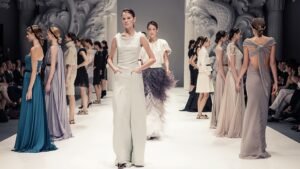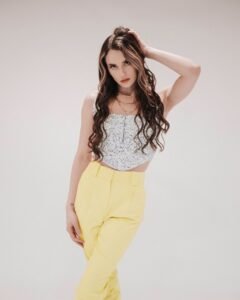Introduction to Fashion and Modeling
Welcome to the captivating world of fashion and modeling, where artistry meets style and creativity takes center stage! In this blog post, we will embark on a journey through the fascinating realm of fashion and modeling, exploring its rich history, the role of designers in shaping trends, the importance of diversity and inclusivity, as well as the creative process behind dazzling fashion shows. Whether you’re an aspiring model or simply have a passion for all things fashionable, get ready to dive into this exciting adventure! So sit back, relax, and let’s explore The Art of Fashion and Modeling: A Creative Journey.
A Brief History of Fashion and Modeling
Fashion and modeling have been intertwined throughout history, their evolution reflecting the changing tastes, cultures, and societal norms. From ancient civilizations to the modern runways, fashion has always played a significant role in expressing personal style and status.
In ancient Egypt, clothing was not only functional but also symbolic of social standing. The pharaohs adorned themselves with luxurious fabrics and intricate jewelry to signify their power and divine connection. In contrast, commoners wore simpler garments made from linen or wool.
The 20th century marked a turning point in the history of fashion and modeling. Coco Chanel revolutionized women’s fashion by introducing casual yet chic designs like trousers for women. This departure from traditional gender roles paved the way for more inclusive styles.
With each passing decade came new trends influenced by cultural movements such as hippie culture in the 1960s or punk rock aesthetics in the 1970s. Fashion designers took inspiration from these subcultures to create unique looks that challenged conventional norms.
Today, diversity is at the forefront of both fashion design and modeling industries as they strive towards inclusivity. Models of different races, sizes, ages are now gracing runways around the world – breaking barriers previously set by society’s narrow standards of beauty.
The dynamic relationship between fashion designers and models continues to shape our perception of style. Designers use models as living mannequins to showcase their creations – it is through them that fabric comes alive! The designer relies on a model’s ability to convey emotions through movement – capturing attention with every step down the runway.
The Role of Designers in the Fashion Industry

Fashion designers are the creative minds behind every stunning ensemble you see on the runway or in a fashion editorial. They are the visionaries who bring their unique ideas to life, transforming fabric into art. These talented individuals play a crucial role in shaping trends and setting new standards in the fashion industry.
Designers not only create beautiful garments but also shape the overall aesthetic and direction of a brand or label. They meticulously craft each piece, paying attention to every detail – from selecting fabrics to designing patterns and creating innovative silhouettes. Their creations become expressions of their creativity and serve as reflections of current cultural influences.
Moreover, designers push boundaries by experimenting with different materials, textures, colors, and techniques. Their boldness allows them to challenge conventional norms and introduce fresh perspectives that captivate audiences worldwide. Through their designs, they inspire others to embrace individuality and express themselves through clothing.
Also Read:
The Importance of Diversity and Inclusivity in Modeling
The fashion industry has long been known for its lack of diversity and inclusivity. Traditionally, models have fit a very specific mold – tall, thin, and predominantly white. However, in recent years there has been a much-needed shift towards embracing different body types, ethnicities, and identities on the runway.
The importance of diversity and inclusivity in modeling cannot be overstated. Representation matters. When people see themselves reflected in the media they consume, it can have a profound impact on their self-esteem and sense of belonging. By including models who come from diverse backgrounds and embody a range of sizes and shapes, the fashion industry is sending a powerful message: beauty comes in all forms.
Furthermore, embracing diversity helps challenge societal norms around beauty standards. It breaks down stereotypes about what is considered “normal” or “acceptable”. Inclusivity allows us to celebrate individuality rather than conforming to unrealistic ideals set by an exclusive few.
While progress has undoubtedly been made towards greater inclusivity in modeling, there is still work to be done. The industry must continue pushing for more representation across all levels – from casting agents to designers choosing diverse models for their shows.
The Creative Process of a Fashion Show

A fashion show is not just about models strutting down the runway in fabulous clothes; it’s an intricate and fascinating creative journey. The process begins with the designer’s vision, as they pour their heart and soul into conceptualizing a collection that reflects their unique style and storytelling.
Once the concept is solidified, designers dive into research, seeking inspiration from various sources such as art, history, nature, or even personal experiences. This exploration fuels their imagination and helps them develop a cohesive theme for the collection.
Next comes the sketching phase, where designers bring their ideas to life on paper. They experiment with different silhouettes, fabrics, textures, and colors to create visually stunning designs that capture attention.
Breaking Into the Industry: Tips for Aspiring Models
So, you’ve decided to pursue a career in modeling. Congratulations on taking this exciting step! The fashion industry can be competitive and challenging, but with the right mindset and preparation, you can make your mark.
It’s crucial to understand that modeling isn’t just about being tall and beautiful. It requires hard work, dedication, and resilience. To start off on the right foot, consider building a strong portfolio of professional photographs showcasing your versatility as a model.
Networking is also key in this industry. Attend casting calls, fashion events, and connect with professionals who can help propel your career forward. Remember to always maintain professionalism and leave a lasting impression wherever you go.
A healthy lifestyle is essential for models too. Regular exercise will keep you fit while maintaining a balanced diet will ensure you have the energy needed for those long photoshoots or runway shows.
The Impact of Social Media on the Fashion World

Social media has revolutionized the fashion industry in ways we could have never imagined. With platforms like Instagram, Facebook, and TikTok dominating our lives, it’s no surprise that they have also taken over the fashion world.
In the past, aspiring models relied heavily on modeling agencies to discover them and book gigs. But now, social media allows anyone with a passion for fashion to showcase their unique style and attract attention from industry professionals.
Fashion influencers have become an integral part of social media culture. These individuals use their platforms to share their personal style and promote brands they love. They have amassed millions of followers who look to them for inspiration when it comes to fashion trends.
Of course, there are challenges that come with this digital era as well. The pressure to constantly produce content can be overwhelming for both models and designers alike. It’s important not only to keep up with current trends but also create meaningful connections with your audience.
Challenges in the Industry and How to Overcome Them
Navigating the fashion and modeling industry can be both exhilarating and daunting. While it offers countless opportunities for creativity, self-expression, and success, there are also challenges that aspiring models need to overcome.
One of the main challenges is facing rejection. Rejection is a common occurrence in this industry, as casting directors have specific criteria they’re looking for. It’s important not to take rejection personally but rather see it as an opportunity for growth. Keep honing your craft, attending auditions, and building connections – persistence pays off!
Another challenge is maintaining a healthy body image amidst societal pressures. The fashion world has made significant strides towards inclusivity and diversity; however, unrealistic beauty standards still persist. Remember that every body shape and size is beautiful in its own way. Surround yourself with positive influences who celebrate individuality.
Conclusion: Why Fashion and Modeling are More than
Fashion and modeling are more than just glamorous industries. They are art forms that allow individuals to express their creativity and unique perspectives. The journey of a fashion designer or model is filled with passion, hard work, and determination.
The creative process behind a fashion show is nothing short of magical. It begins with an idea or concept that sparks inspiration for designers who then bring it to life through sketches and prototypes. From casting models who embody their vision to choosing hair stylists and makeup artists who can translate their aesthetic onto each face – every decision contributes to creating an immersive experience for both the audience and participants.
Read More:



